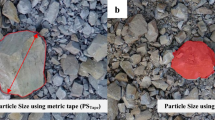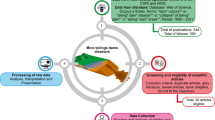Abstract
Geostatistics applied to radiological evaluation of nuclear premises provides methods to estimate radiological activities, together with their associated uncertainty. It enables a sophisticated sampling methodology combining radiation map and destructive samples. The radiological assessment is divided in two steps: first, a regular control of the surface activity is performed. Then, to assess the true contamination, concrete samples are collected and analyses are performed at several locations within the premises. These two types of measurement are first dealt separately, then cokriging techniques are applied to estimate the contamination over the premise, taking both information into account. This paper presents a methodological study of geostatistical and computational approaches to target suitable areas for additional radiological measures. In order to compare the proposed augmented sampling designs, several optimization criteria are taken into account. Their diversity ensures the coverage of a wide range of real problematics. Two algorithms (greedy algorithm and simulated annealing) are developed to optimize the chosen criterion value as a function of the location of the additional points. The sampling scenarios obtained with the different algorithms are compared in terms of optimization performance and computational efficiency.









Similar content being viewed by others
References
Bichon BJ, Eldred MS, Swiler LP, Mahadevan S, McFarland JM (2008) Efficient global reliability analysis for nonlinear implicit performance functions. AIAA J 46(10):2459–2468
Chilès J-P, Delfiner P (1999) Geostatistics: modeling spatial uncertainty. Wiley, New York
Desnoyers Y (2010) Approche méthodologique pour la caractérisation géostatistique des contaminations radiologiques dans les installations nucléaires. PhD, Ecole Nationale Supérieure des Mines de Paris
Desnoyers Y, Chilès J-P, Dubot D, Jeannée N, Idasiak J-M (2011) Geostatistics for radiological evaluation: study of structuring of extreme values. Stoch Environ Res Risk Assess 25(8):1031–1037
Goovaerts P (1999) Geostatistics in soil science: state-of-the-art and perspectives. Geoderma 89(12):1–45
Goulard M, Voltz M (1992) Linear coregionalization model: tools for estimation and choice of cross-variogram matrix. Math Geol 24(3):269–286
Jeannée N, Desnoyers Y, Lamadie F, Iooss B (2008) Geostatistical sampling optimization of contaminated premises. DEM, Avignon
Kirkpatrick S, Gelatt CD, Vecchi MP (1983) Optimization by simulated annealing. Science 220(4598):671–680
Krause A, Guestrin C (2007) Near-optimal observation selection using submodular functions. In: AAAI’07 proceedings of the 22nd national conference on artificial intelligence, vol 2
Modis C, Papantonopoulos G, Komnitsas K, Papaodysseus K (2008) Mapping optimization based on sampling size in earth related and environmental phenomena. Stoch Environ Res Risk Assess 22(1):83–93
Nemhauser GL, Wolsey LA, Fisher ML (1978) An analysis of approximations for maximizing submodular set functions. Math program 14(1):265–294
Ranjan P, Bingham D, Michailidis G (2008) Sequential experiment design for contour estimation from complex computer codes. Technometrics 50:527–541
Rivoirard J (1994) Introduction to disjunctive kriging and non-linear geostatistics. Clarendon Press, Oxford
Romary T, Fouquet C, Malherbe L (2011) Sampling design for air quality measurement surveys: an optimisation approach. Atmos Environ 45(21):3613–3620
Weyland D (2008) Simulated annealing, its parameter settings and the longest common subsequence problem. ACM Press, New York, pp 803–810
Author information
Authors and Affiliations
Corresponding author
Rights and permissions
About this article
Cite this article
Bechler, A., Romary, T., Jeannée, N. et al. Geostatistical sampling optimization of contaminated facilities. Stoch Environ Res Risk Assess 27, 1967–1974 (2013). https://doi.org/10.1007/s00477-013-0731-0
Published:
Issue Date:
DOI: https://doi.org/10.1007/s00477-013-0731-0




